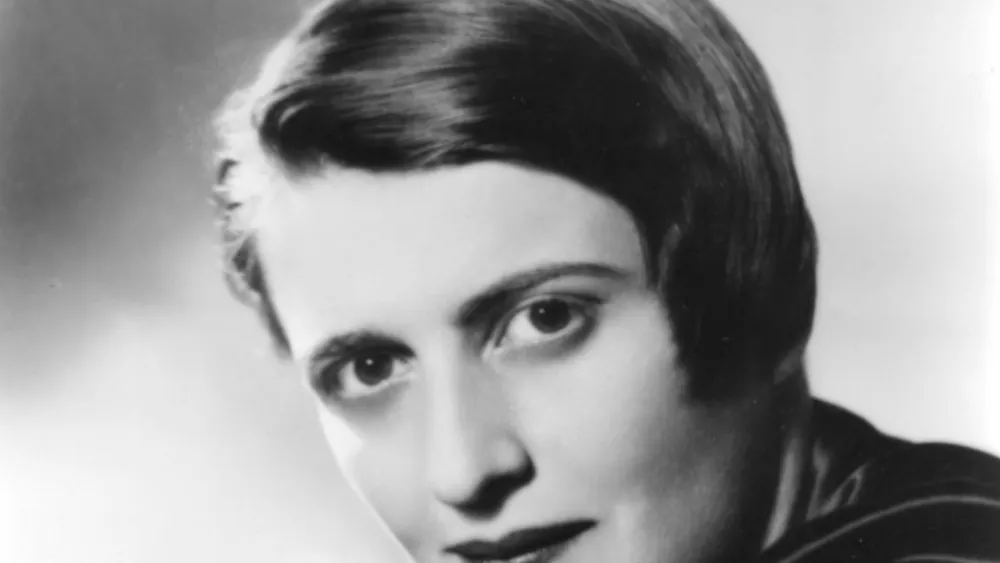Ayn Rand, originally named Alisa Rosenbaum, was an influential Russian-American writer and philosopher. She became well-known for her fiction and for creating Objectivism. She moved to the United States in 1926 and became influential with her book “The Fountainhead” in 1943. Another popular book she wrote was “Atlas Shrugged” in 1957.
Rand believed in using reason, supporting rational egoism, and was against altruism. She also favored laissez-faire capitalism. Even though some people criticized her, her books sold a lot, and her ideas influenced certain political groups. This includes the right-libertarians and conservatives through the Objectivist movement.
Early Life in Comfort
Ayn was born on February 24, 1905, into a Jewish family that enjoyed a comfortable life in what was once the Russian Empire. Ayn was the oldest of three daughters to Zinovy Zakharovich Rosenbaum, a pharmacist, and Anna Borisovna (formerly Kaplan).
However, Ayn’s life took a turn when she was 12 years old. The October Revolution, led by the Bolsheviks and headed by Vladimir Lenin, disrupted her family’s peaceful existence. The government took over her father’s pharmacy, prompting the family to escape to Yevpatoria in Crimea. The White Army initially controlled this city during the Russian Civil War.
Ayn Rand: Educational Milestone
In June 1921, after completing her high school education in Yevpatoria, Ayn Rand and her family returned to Petrograd (Saint Petersburg’s then-name). Unfortunately, harsh conditions marked their homecoming, and they sometimes faced the daunting prospect of near-starvation. The challenges of revolution and war during her early years left a lasting impact on Ayn Rand’s life and shaped the course of her future endeavors.
After the Russian Revolution opened doors for women to attend universities, Ayn Rand was among the first to seize the opportunity and enroll at Petrograd State University. At 16, she embarked on her studies in the Department of Social Pedagogy, with a focus on history.
Foreign Intervention: Reinstatement After Complaints from Scientists
Ayn’s academic journey was hindered when she, along with other bourgeois students, was removed from the university just before graduating.
Complaints from a group of foreign scientists led to the reinstatement of many purged students, including Rand. She completed her studies at the renamed Leningrad State University in October 1924.
Following this, she spent a year at the State Technicum for Screen Arts in Leningrad. During her time there, she wrote her first published work, an essay about the Polish actress Pola Negri.
Around this period, Ayn Rand made a significant decision about her professional identity, choosing the surname Rand for her writing career. She also adopted the first name Ayn, pronounced as “ine.” These choices marked the beginning of her journey as a writer and thinker.
Ayn Rand: Dreams of Hollywood
In 1925, Ayn Rand obtained a visa to visit relatives in Chicago and arrived in New York the following year. Aspiring to be a screenwriter, she lived with relatives, mastering English before venturing to Hollywood. A fortuitous meeting with director Cecil B. DeMille paved her way into the film industry. This journey culminated in her marriage to actor Frank O’Connor in 1929. Despite earnest efforts, Rand encountered difficulties bringing her family to the United States.
Screenplay Triumph and International Resonance
Ayn Rand’s initial literary triumph came with selling her screenplay “Red Pawn” to Universal Studios in 1932, though it remained unproduced. Her courtroom drama, “Night of January 16th,” staged in Hollywood in 1934, found success on Broadway in 1935, featuring audience-selected endings. Relocating to New York City in 1934, Rand oversaw revisions for the Broadway production with her husband, Frank O’Connor.
Her debut novel, the semi-autobiographical “We the Living,” hit shelves in 1936. Set in Soviet Russia, it delves into the individual-state conflict. Initial sales were sluggish, prompting the American publisher to let it go out of print. However, European editions continued to resonate. Rand adapted it into a play, but the Broadway run was brief. With the success of her later works, Rand released a revised version in 1959, selling over three million copies.
Ayn Rand: Major Novel Takes Shape
Commencing her major novel “The Fountainhead” in December 1935, Rand paused in 1937 to write the novella “Anthem.” This dystopian narrative envisions a future dominated by totalitarian collectivism, erasing the word “I” in favor of “we.” Although published in England in 1938, finding an American publisher was elusive then. Rand’s later success enabled the release of a revised version in 1946, selling over 3.5 million copies.
Ayn Rand: Intellectual Renaissance
After the triumph of “The Fountainhead,” Ayn Rand fostered a captivating intellectual circle in 1951, uniting luminaries like Alan Greenspan, Nathan Blumenthal (later Nathaniel Branden), and Leonard Peikoff.
Transcending mere discussions, Rand graciously shared drafts of her upcoming masterpiece, “Atlas Shrugged.” Published in 1957, this opus, deemed Rand’s magnum opus, fervently champions Objectivism, elucidating the essence of rational self-interest.
Although encountering critical headwinds, the novel soared as an international bestseller, signaling Rand’s shift from a celebrated novelist to a revered philosopher.
Nathaniel Branden’s initiation of the Nathaniel Branden Institute in 1958, alongside “The Objectivist Newsletter” in 1962, aimed to increase Rand’s profound ideas but stirred debates over intellectual conformity and excessive reverence.
Ayn Rand: Fearless Advocacy
Throughout the 1960s and 70s, Ayn Rand actively propagated her Objectivist philosophy through various nonfiction works and speeches at educational institutions.
Delivering annual lectures at the Ford Hall Forum, she fearlessly addressed controversial topics. These include expressing opinions on abortion rights, condemning the Vietnam War and military draft while criticizing draft dodgers.
She also supported Israel in the Yom Kippur War, asserting the rights of European colonists over Native American lands and expressing disapproval of homosexuality despite advocating for the repeal of related laws. Rand endorsed Republican candidates, notably Barry Goldwater, in 1964.
Drastic Actions in the Wake of Betrayal
In 1964, Nathaniel Branden’s affair with actress Patrecia Scott, concealed from Rand, came to light in 1968. Despite her prior separation from Branden, Rand terminated her relationship with both, leading to the closure of the Nathaniel Branden Institute.
Rand publicly repudiated Nathaniel Branden for perceived dishonesty and irrational behavior. In the subsequent years, Rand distanced herself from several close associates.

Struggle with Lung Cancer
Facing lung cancer in 1974 due to heavy smoking, Rand underwent surgery. She retired from her newsletter in 1976 and reluctantly accepted Social Security and Medicare enrollment. Her involvement in the Objectivist movement waned, particularly after her husband died in 1979.
Among her final endeavors was an unfinished television adaptation of “Atlas Shrugged.”
On March 6, 1982, Ayn Rand passed away from heart failure at her New York City home. Her funeral featured a unique 6-foot floral arrangement shaped like a dollar sign. In her will, Rand designated Leonard Peikoff as her heir.
The Lasting Impression of Ayn Rand on Libertarianism
Though disassociating herself from conservative and libertarian labels, Ayn Rand has left an enduring impact on right-wing politics and libertarianism.
She’s widely considered one of the key figures in the early development of American libertarianism and is deemed the most influential libertarian of the 20th century.
Despite opposition and criticism from some conservatives, Rand’s ideas resonate among Republican politicians.
Her influence extends globally, impacting figures like Sajid Javid, Siv Jensen, and Ayelet Shaked. The 2007–2008 financial crisis revived interest in her works, with Atlas Shrugged drawing parallels and sparking debates over her economic philosophy.











